(Page créée avec « Contrary to preservation by means of heat (e.g sterilisation) or freezing, which can in turn cause the development of for example the toxin botulinum, lacto-fermentation i... ») |
(update property name) |
||
| (39 révisions intermédiaires par 4 utilisateurs non affichées) | |||
| Ligne 1 : | Ligne 1 : | ||
| − | {{ | + | {{Tuto Details |
| + | |Main_Picture=Conserves_lactofermentées_6.jpg | ||
| + | |Licences=Attribution (CC BY) | ||
| + | |Description=Preserve your raw vegetables for months with this lacto-fermentation technique. | ||
| + | |Area=Food, Health | ||
|Type=Tutorial | |Type=Tutorial | ||
| − | |||
| − | |||
| − | |||
|Difficulty=Easy | |Difficulty=Easy | ||
| + | |Duration=30 | ||
| + | |Duration-type=minute(s) | ||
|Cost=0 | |Cost=0 | ||
|Currency=EUR (€) | |Currency=EUR (€) | ||
| − | | | + | |Tags=lactique, fermenté, conserve, lactofermentation, conservation, fruit, légume, acide, bocaux, bocal, Low-tech Tour France, NomadeDesMers |
| − | |||
| − | |||
| − | |||
|SourceLanguage=fr | |SourceLanguage=fr | ||
|Language=en | |Language=en | ||
|IsTranslation=1 | |IsTranslation=1 | ||
}} | }} | ||
| − | {{ | + | {{Introduction |
| − | |Introduction=This tutorial has been created in collaboration with Claire Yobé, a lacto-fermentation instructor with over thirty years of experience in | + | |Introduction=This tutorial has been created in collaboration with Claire Yobé, a lacto-fermentation instructor with over thirty years of experience in the field. |
The aim is to easily preserve surplus vegetables for long-term storage, whether from your vegetable patch (in Summer for example), or because you have bought more vegetables than you needed. | The aim is to easily preserve surplus vegetables for long-term storage, whether from your vegetable patch (in Summer for example), or because you have bought more vegetables than you needed. | ||
| Ligne 22 : | Ligne 22 : | ||
Key facts on food wastage: | Key facts on food wastage: | ||
| − | * 1/3 of food produced around the world goes off or is wasted | + | * 1/3 of food produced around the world goes off or is wasted |
| − | * In France, 50% of waste happens at home | + | * In France, 50% of waste happens at home |
| − | * A person in France wastes 20kg of food per year | + | * A person in France wastes 20kg of food per year |
| − | * 19 % of fruit and 31% of vegetables are wasted, making these the most | + | * 19 % of fruit and 31% of vegetables are wasted, making these the produce we waste the most |
What is lacto-fermentation, or lactic acid fermentation? | What is lacto-fermentation, or lactic acid fermentation? | ||
| Ligne 31 : | Ligne 31 : | ||
Lacto-fermentation is the conversion of sugars into lactic acid by lactic acid bacteria (naturally present specific microorganisms). | Lacto-fermentation is the conversion of sugars into lactic acid by lactic acid bacteria (naturally present specific microorganisms). | ||
| − | This method of fermentation has been used for centuries to preserve milk (e.g yoghurt), vegetables (e.g | + | This method of fermentation has been used for centuries to preserve milk (e.g yoghurt), vegetables (e.g sauerkraut), meat (e.g. cured sausage) and even fish (e.g fish sauce). |
How is it possible to preserve vegetables by means of lactic acid fermentation? | How is it possible to preserve vegetables by means of lactic acid fermentation? | ||
| Ligne 37 : | Ligne 37 : | ||
Vegetables carry microorganisms on their surfaces (microscopic fungi, bacteria) which, when left in the open air, cause them to rot. The absence of air (anaerobic conditions) and a small quantity of salt to inhibit other bacteria, encourages the lactic acid bacteria to grow: this is the start of the lacto-fermentation process. | Vegetables carry microorganisms on their surfaces (microscopic fungi, bacteria) which, when left in the open air, cause them to rot. The absence of air (anaerobic conditions) and a small quantity of salt to inhibit other bacteria, encourages the lactic acid bacteria to grow: this is the start of the lacto-fermentation process. | ||
| − | These bacteria grow by feeding off the sugars present in the food, and converting them into lactic acid. The amount of lactic acid gradually increases and the | + | These bacteria grow by feeding off the sugars present in the food, and converting them into lactic acid. The amount of lactic acid gradually increases, and the vegetable juice becomes increasingly acidic. |
| − | This acidity neutralises the rotting process. When the | + | This acidity neutralises the rotting process. When the medium is acidic enough (approx. pH 4), the lactic acid bacteria are also inhibited. The product becomes stable, which allows for long term storage of up to several months and sometimes even years. |
| − | What kind of vegetables can be preserved | + | What kind of vegetables can be preserved by lacto-fermentation? |
Nearly all vegetables which are eaten raw can be preserved this way. (E.g cabbage, cucumber, carrots, beetroot, etc...) | Nearly all vegetables which are eaten raw can be preserved this way. (E.g cabbage, cucumber, carrots, beetroot, etc...) | ||
| Ligne 67 : | Ligne 67 : | ||
They should be part of a varied and balanced diet. | They should be part of a varied and balanced diet. | ||
| − | Are there any risks with lacto-fermentation? | + | Are there any risks involved with lacto-fermentation? |
| − | Contrary to preservation by means of heat (e.g sterilisation) or freezing, which can in turn cause the | + | Contrary to preservation by means of heat (e.g sterilisation) or freezing, which can in turn cause the growth of, for example, the toxin botulinum, lacto-fermentation is a very safe method. |
| − | + | The acidity of the medium prevents the growth of pathogens. | |
| − | + | Nevertheless, if in doubt and bad odours or peculiar colours appear, throw the preserve away. | |
| + | }} | ||
| + | {{TutoVideo | ||
| + | |VideoType=Youtube | ||
| + | |VideoURLYoutube=https://www.youtube.com/watch?v=SKLeqX0O0NA | ||
}} | }} | ||
| − | {{ | + | {{Materials |
| − | |Material=* | + | |Material=* Vegetables which are usually eaten raw |
| − | * | + | * Table salt |
| − | * | + | * Water |
| − | |Tools=* | + | |Tools=* Jar with its respective lid, (if possible a glass lid with seal) |
}} | }} | ||
| − | {{ | + | {{Tuto Step |
| − | + | |Step_Title=Preparing the vegetables: | |
| + | |Step_Content=* Peel and wash the vegetables carefully | ||
| + | * Depending on preference, grate or cut them into dice or strips. | ||
| + | * Leave those vegetables which are usually left whole as they are, following washing (e.g green beans). | ||
|Step_Picture_00=Conserves_lactofermentées_1.JPG | |Step_Picture_00=Conserves_lactofermentées_1.JPG | ||
|Step_Picture_01=Conserves_lactofermentées_2.JPG | |Step_Picture_01=Conserves_lactofermentées_2.JPG | ||
|Step_Picture_02=Conserves_lactofermentées_3.JPG | |Step_Picture_02=Conserves_lactofermentées_3.JPG | ||
| − | |||
| − | |||
| − | |||
| − | |||
}} | }} | ||
| − | {{ | + | {{Tuto Step |
| + | |Step_Title=Preparing the jars: | ||
| + | |Step_Content=* Clean the jars carefully | ||
|Step_Picture_00=Conserves_lactofermentées_bocaux.jpg | |Step_Picture_00=Conserves_lactofermentées_bocaux.jpg | ||
| − | |||
| − | |||
}} | }} | ||
| − | {{ | + | {{Tuto Step |
| + | |Step_Title=Preserving grated or cut up vegetables: | ||
| + | |Step_Content=* Ensure your hands are clean | ||
| + | * Place a first layer of vegetables at the bottom of the jar (2cm) | ||
| + | * Sprinkle with a pinch of salt | ||
| + | * Press the layer of vegetables down with your hands | ||
| + | Note: Pressing down allows for the salt to penetrate the vegetables so as to encourage the extraction of juices and get rid of air | ||
| + | * Repeat the procedure until the jar is full | ||
| + | * Leave a gap of 1 to 2 cm between the last layer of vegetables and the lid, as fermentation produces gas and the juices may overflow if the jar is too full | ||
| + | * Close the jar | ||
| + | * Leave to rest for 3 days to start the fermentation process of the naturally present lactic acid bacteria | ||
| + | * If the level of vegetables has reduced due to the juice extraction from the salt, add more layers | ||
| + | * Check all of the vegetables are covered by their own juices to the top of the jar: these juices ensure anaerobic conditions, namely the absence of oxygen | ||
|Step_Picture_00=Conserves_lactofermentées_4.JPG | |Step_Picture_00=Conserves_lactofermentées_4.JPG | ||
|Step_Picture_01=Conserves_lactofermentées_5.JPG | |Step_Picture_01=Conserves_lactofermentées_5.JPG | ||
| − | |||
| − | |||
| − | |||
| − | |||
| − | |||
| − | |||
| − | |||
| − | |||
| − | |||
| − | |||
| − | |||
| − | |||
}} | }} | ||
| − | {{ | + | {{Tuto Step |
| − | |Step_Title= | + | |Step_Title=Preserving whole vegetables: |
| − | |Step_Content=* | + | |Step_Content=* Fill the jar with as many vegetables as possible |
| − | * | + | * Add salty water (10g of salt for 1 kg of vegetables) |
| − | * | + | * Check all of the vegetables are fully submerged in the water, the water ensures the anaerobic conditions, namely the absence of oxygen |
| − | * | + | * Close the jar |
| − | * | + | * Leave to rest for 3 days to start the fermentation process of the naturally present lactic acid bacteria |
| + | }} | ||
| + | {{Tuto Step | ||
| + | |Step_Title=Storage: | ||
| + | |Step_Content=* Following the process, store the preserve in a dry place, out of sunlight and if possible, in the coolest part of the house/flat (e.g cellar, pantry or basement) | ||
| + | * Wait 6 weeks for the fermentation process to have completed and for the product to stabilise. Then, the jar can be stored for several months / years. | ||
}} | }} | ||
| − | {{ | + | {{Tuto Step |
| − | |Step_Title= | + | |Step_Title=Consumption: |
| − | |Step_Content=* | + | |Step_Content=* A jar may be consumed over several days once opened, though it is still a good idea to choose the size of the jar depending on the number of people living in the household |
| − | * | + | * Consume a small amount of lacto-fermented vegetables every day so as to make the most of its nutritional value. |
| + | (back to introduction) | ||
}} | }} | ||
| − | {{ | + | {{Tuto Step |
| − | |Step_Title= | + | |Step_Title=Kimchi recipe |
| − | |Step_Content=* | + | |Step_Content=Le Kimchi est une recette coréenne traditionnelle. Elle est basée sur la lactofermentation du choux et d'épices. |
| − | + | ||
| + | * 2 kg de chou chinois | ||
| + | * 2 poireaux | ||
| + | * 1/2 navet long | ||
| + | * 3 gousses d’ail hachées | ||
| + | * 2 cuillerées à café de gingembre frais râpé fin | ||
| + | * 1 ou 2 cuillerée à café de sauce de poisson (optionnel) | ||
| + | * 1 cuillerée à soupe de piment rouge haché | ||
| + | * 1 cuillerée à soupe de sésame grillé | ||
| + | * 1 cuillère à soupe de sucre | ||
| + | * 100 à 160g de gros sel | ||
| + | |||
| + | # Coupez le chou en lamelles dans le sens de la longueur et mettez-le dans un saladier rempli d’eau tiède salée. Saupoudrez le chou de gros sel (à mettre entre chaque feuille). Laissez reposer et dégorger pendant une nuit. | ||
| + | # Le lendemain, rincez les lamelles de chou à l’eau et égouttez-les. Dans un autre saladier: Coupez le navet et les poireaux en fines lamelles d’environ 5 cm | ||
| + | # Mélangez les ingrédients pour faire la pâte d’épices : gingembre,piment rouge, ail,sucre et sauce de poisson. Il faut tout éplucher ou râper afin de faire la pâte. Étalez cette pâte entre les feuilles de chou. Déposez les morceaux de chou dans un grand récipient. Saupoudrez avec un peu de sésame grillé. | ||
| + | # Placez un couvercle ou une assiette sur le récipient, ou fermez-le hermétiquement. Il faut maintenant attendre 4 à 5 jours pour que le kimchi fermente. Il est à consommer dans les jours suivants l'ouverture du pot et peut se conserver environ trois semaines au frigo. | ||
| + | |Step_Picture_00=Conserves_lactofermentées_kimchi_4.jpg | ||
| + | |Step_Picture_01=Conserves_lactofermentées_Kimchi1.jpg | ||
}} | }} | ||
| − | {{ | + | {{Notes |
| − | |Notes=* | + | |Notes=<div class="mw-translate-fuzzy"> |
| − | * | + | * Video tutorial created by Camille Duband and instructions written by Pierre-Alain Lévêque for the Low-Tech Tour, April 2018. |
| + | * Know-how delivered by Claire Yobé, Keroueze Farm | ||
* ARTE, [https://www.arte.tv/player/v3/index.php?json_url=https%3A%2F%2Fapi.arte.tv%2Fapi%2Fplayer%2Fv1%2Fconfig%2Ffr%2F074787-105-A%3Fautostart%3D1%26lifeCycle%3D1&config=arte_nude&lang=fr_FR Le gaspillage alimentaire en 7 chiffres clés] | * ARTE, [https://www.arte.tv/player/v3/index.php?json_url=https%3A%2F%2Fapi.arte.tv%2Fapi%2Fplayer%2Fv1%2Fconfig%2Ffr%2F074787-105-A%3Fautostart%3D1%26lifeCycle%3D1&config=arte_nude&lang=fr_FR Le gaspillage alimentaire en 7 chiffres clés] | ||
* National Geographic, [https://www.nationalgeographic.fr/environnement/un-tiers-des-aliments-produits-est-perdu-ou-gaspille Un tiers des aliments produits est perdu ou gaspillé] | * National Geographic, [https://www.nationalgeographic.fr/environnement/un-tiers-des-aliments-produits-est-perdu-ou-gaspille Un tiers des aliments produits est perdu ou gaspillé] | ||
* Wikipedia, [https://fr.wikipedia.org/wiki/Fermentation_lactique lactofermentation] | * Wikipedia, [https://fr.wikipedia.org/wiki/Fermentation_lactique lactofermentation] | ||
* [https://nicrunicuit.com/category/sante/ Blog ni cru ni cuit] | * [https://nicrunicuit.com/category/sante/ Blog ni cru ni cuit] | ||
| + | |||
| + | This English translation has been possible thanks to the PerMondo project: Free translation of website and documents for non-profit organisations. A project managed by Mondo Agit. | ||
| + | Translator: Annie Eve | ||
| + | </div> | ||
}} | }} | ||
| − | {{ | + | {{Tuto Status |
| − | |Complete= | + | |Complete=Published |
}} | }} | ||
| + | {{Separator}} | ||
Version du 22 octobre 2019 à 16:04
Description
Preserve your raw vegetables for months with this lacto-fermentation technique.
Sommaire
Sommaire
- 1 Description
- 2 Sommaire
- 3 Introduction
- 4 Video d'introduction
- 5 Étape 1 - Preparing the vegetables:
- 6 Étape 2 - Preparing the jars:
- 7 Étape 3 - Preserving grated or cut up vegetables:
- 8 Étape 4 - Preserving whole vegetables:
- 9 Étape 5 - Storage:
- 10 Étape 6 - Consumption:
- 11 Étape 7 - Kimchi recipe
- 12 Notes et références
- 13 Commentaires
Introduction
This tutorial has been created in collaboration with Claire Yobé, a lacto-fermentation instructor with over thirty years of experience in the field.
The aim is to easily preserve surplus vegetables for long-term storage, whether from your vegetable patch (in Summer for example), or because you have bought more vegetables than you needed.
Key facts on food wastage:
- 1/3 of food produced around the world goes off or is wasted
- In France, 50% of waste happens at home
- A person in France wastes 20kg of food per year
- 19 % of fruit and 31% of vegetables are wasted, making these the produce we waste the most
What is lacto-fermentation, or lactic acid fermentation?
Lacto-fermentation is the conversion of sugars into lactic acid by lactic acid bacteria (naturally present specific microorganisms).
This method of fermentation has been used for centuries to preserve milk (e.g yoghurt), vegetables (e.g sauerkraut), meat (e.g. cured sausage) and even fish (e.g fish sauce).
How is it possible to preserve vegetables by means of lactic acid fermentation?
Vegetables carry microorganisms on their surfaces (microscopic fungi, bacteria) which, when left in the open air, cause them to rot. The absence of air (anaerobic conditions) and a small quantity of salt to inhibit other bacteria, encourages the lactic acid bacteria to grow: this is the start of the lacto-fermentation process.
These bacteria grow by feeding off the sugars present in the food, and converting them into lactic acid. The amount of lactic acid gradually increases, and the vegetable juice becomes increasingly acidic.
This acidity neutralises the rotting process. When the medium is acidic enough (approx. pH 4), the lactic acid bacteria are also inhibited. The product becomes stable, which allows for long term storage of up to several months and sometimes even years.
What kind of vegetables can be preserved by lacto-fermentation?
Nearly all vegetables which are eaten raw can be preserved this way. (E.g cabbage, cucumber, carrots, beetroot, etc...)
What are the nutritional and health benefits of lacto-fermented vegetables?
1) They aid digestion and nutrient absorption.
Enzymes in lactic acid bacteria "pre-digest" vegtables, which helps the digestion process as well as the absorption of nutrients and minerals by the body.
2) They are a source of vitamins.
Lacto-fermented vegetables have the same amount of vitamins, and sometimes more, as raw vegetables.
3) They help the intestines and immune system function properly.
Lactic acid bacteria are "pro-biotics" for the gut flora which play an important role as barriers for the immune system.
How can we consume lacto-fermented vegetables?
Lacto-fermented vegetables can be consumed frequently, on a daily basis even, for example as a side dish.
Eating a lot in one go can cause stomach pains due to its elevated acidity levels.
They should be part of a varied and balanced diet.
Are there any risks involved with lacto-fermentation?
Contrary to preservation by means of heat (e.g sterilisation) or freezing, which can in turn cause the growth of, for example, the toxin botulinum, lacto-fermentation is a very safe method.
The acidity of the medium prevents the growth of pathogens.
Nevertheless, if in doubt and bad odours or peculiar colours appear, throw the preserve away.Youtube
Matériaux
- Vegetables which are usually eaten raw
- Table salt
- Water
Outils
- Jar with its respective lid, (if possible a glass lid with seal)
Étape 1 - Preparing the vegetables:
- Peel and wash the vegetables carefully
- Depending on preference, grate or cut them into dice or strips.
- Leave those vegetables which are usually left whole as they are, following washing (e.g green beans).
Étape 3 - Preserving grated or cut up vegetables:
- Ensure your hands are clean
- Place a first layer of vegetables at the bottom of the jar (2cm)
- Sprinkle with a pinch of salt
- Press the layer of vegetables down with your hands
Note: Pressing down allows for the salt to penetrate the vegetables so as to encourage the extraction of juices and get rid of air
- Repeat the procedure until the jar is full
- Leave a gap of 1 to 2 cm between the last layer of vegetables and the lid, as fermentation produces gas and the juices may overflow if the jar is too full
- Close the jar
- Leave to rest for 3 days to start the fermentation process of the naturally present lactic acid bacteria
- If the level of vegetables has reduced due to the juice extraction from the salt, add more layers
- Check all of the vegetables are covered by their own juices to the top of the jar: these juices ensure anaerobic conditions, namely the absence of oxygen
Étape 4 - Preserving whole vegetables:
- Fill the jar with as many vegetables as possible
- Add salty water (10g of salt for 1 kg of vegetables)
- Check all of the vegetables are fully submerged in the water, the water ensures the anaerobic conditions, namely the absence of oxygen
- Close the jar
- Leave to rest for 3 days to start the fermentation process of the naturally present lactic acid bacteria
Étape 5 - Storage:
- Following the process, store the preserve in a dry place, out of sunlight and if possible, in the coolest part of the house/flat (e.g cellar, pantry or basement)
- Wait 6 weeks for the fermentation process to have completed and for the product to stabilise. Then, the jar can be stored for several months / years.
Étape 6 - Consumption:
- A jar may be consumed over several days once opened, though it is still a good idea to choose the size of the jar depending on the number of people living in the household
- Consume a small amount of lacto-fermented vegetables every day so as to make the most of its nutritional value.
(back to introduction)
Étape 7 - Kimchi recipe
Le Kimchi est une recette coréenne traditionnelle. Elle est basée sur la lactofermentation du choux et d'épices.
- 2 kg de chou chinois
- 2 poireaux
- 1/2 navet long
- 3 gousses d’ail hachées
- 2 cuillerées à café de gingembre frais râpé fin
- 1 ou 2 cuillerée à café de sauce de poisson (optionnel)
- 1 cuillerée à soupe de piment rouge haché
- 1 cuillerée à soupe de sésame grillé
- 1 cuillère à soupe de sucre
- 100 à 160g de gros sel
- Coupez le chou en lamelles dans le sens de la longueur et mettez-le dans un saladier rempli d’eau tiède salée. Saupoudrez le chou de gros sel (à mettre entre chaque feuille). Laissez reposer et dégorger pendant une nuit.
- Le lendemain, rincez les lamelles de chou à l’eau et égouttez-les. Dans un autre saladier: Coupez le navet et les poireaux en fines lamelles d’environ 5 cm
- Mélangez les ingrédients pour faire la pâte d’épices : gingembre,piment rouge, ail,sucre et sauce de poisson. Il faut tout éplucher ou râper afin de faire la pâte. Étalez cette pâte entre les feuilles de chou. Déposez les morceaux de chou dans un grand récipient. Saupoudrez avec un peu de sésame grillé.
- Placez un couvercle ou une assiette sur le récipient, ou fermez-le hermétiquement. Il faut maintenant attendre 4 à 5 jours pour que le kimchi fermente. Il est à consommer dans les jours suivants l'ouverture du pot et peut se conserver environ trois semaines au frigo.
Notes et références
- Video tutorial created by Camille Duband and instructions written by Pierre-Alain Lévêque for the Low-Tech Tour, April 2018.
- Know-how delivered by Claire Yobé, Keroueze Farm
- ARTE, Le gaspillage alimentaire en 7 chiffres clés
- National Geographic, Un tiers des aliments produits est perdu ou gaspillé
- Wikipedia, lactofermentation
- Blog ni cru ni cuit
This English translation has been possible thanks to the PerMondo project: Free translation of website and documents for non-profit organisations. A project managed by Mondo Agit. Translator: Annie Eve
Published
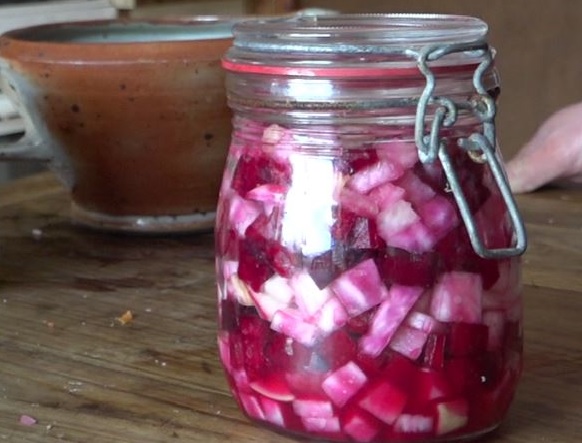
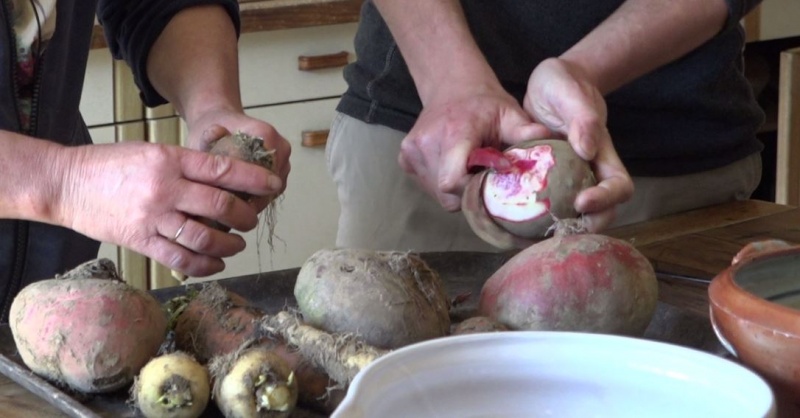
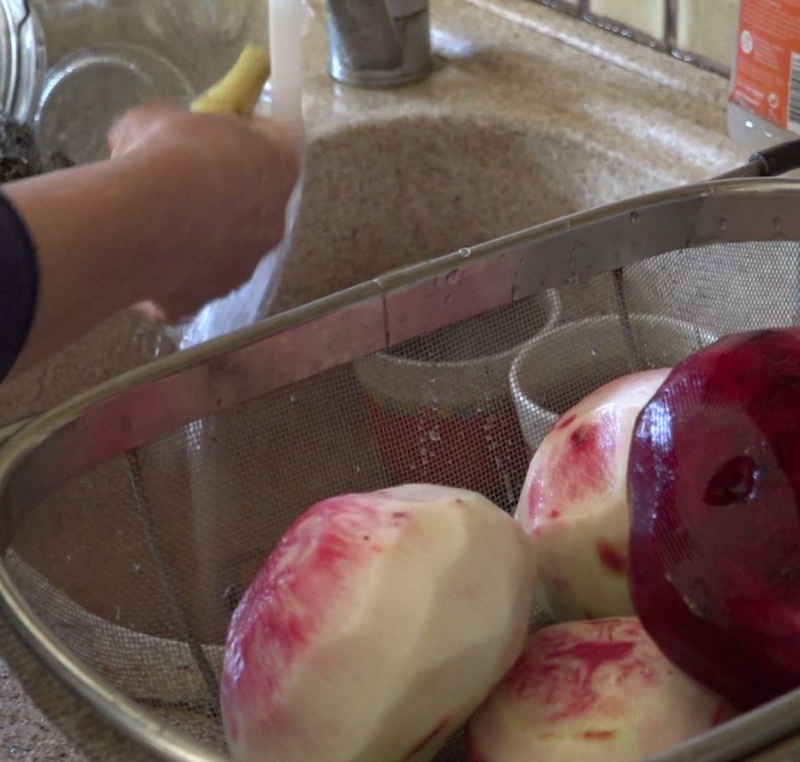
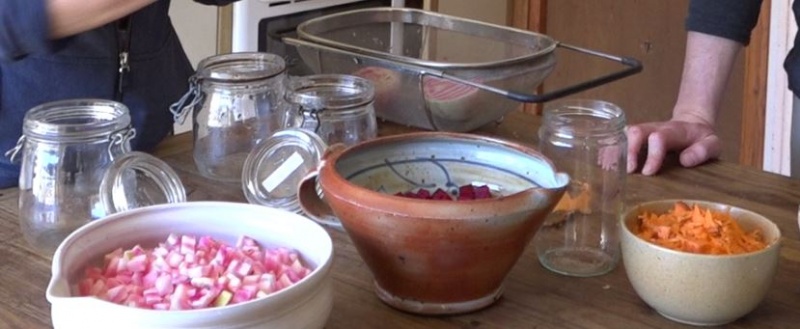
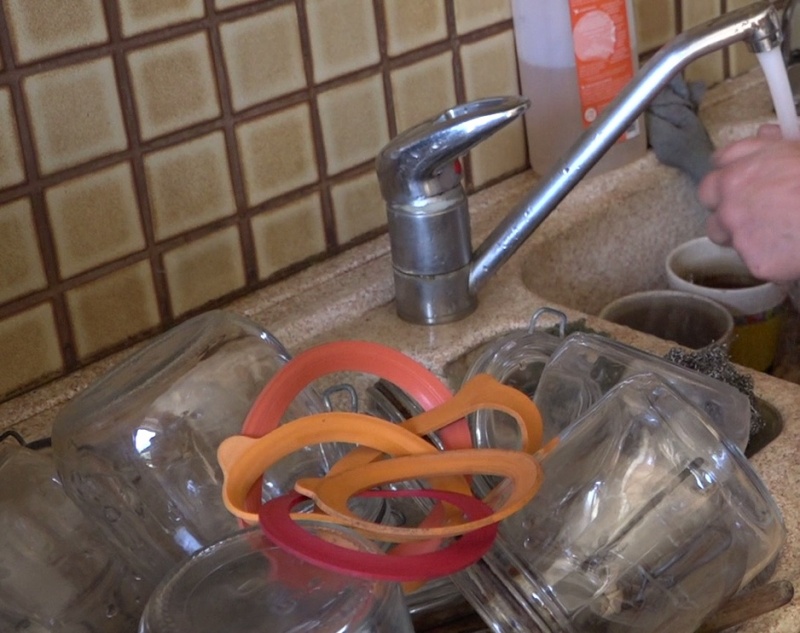
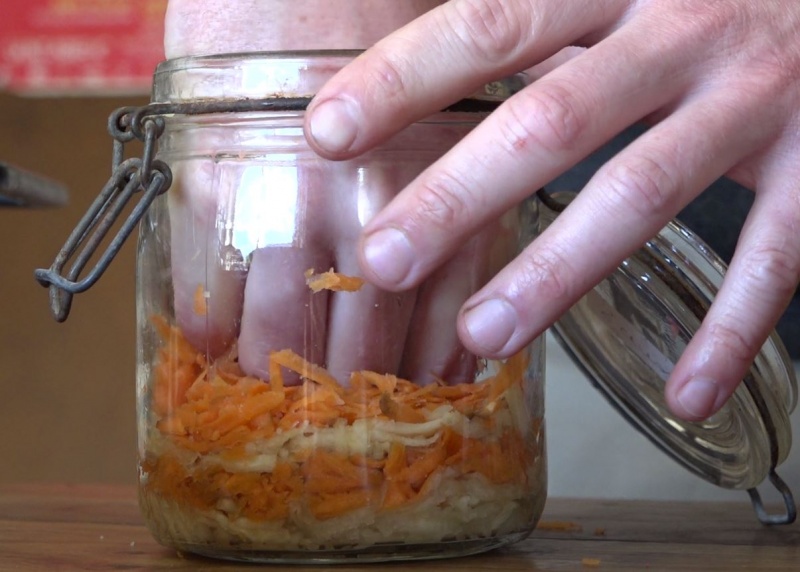
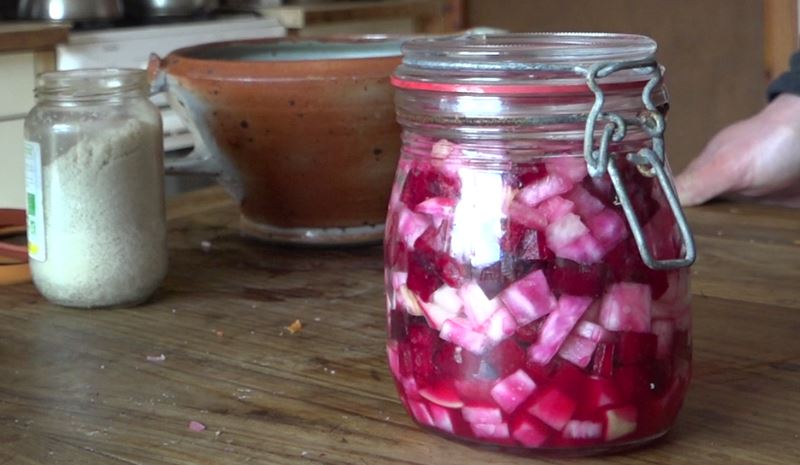
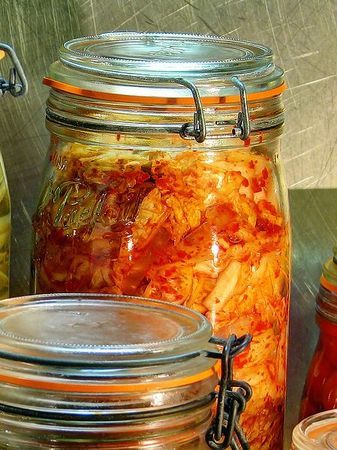
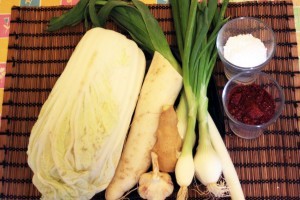
 Français
Français English
English Deutsch
Deutsch Español
Español Italiano
Italiano Português
Português